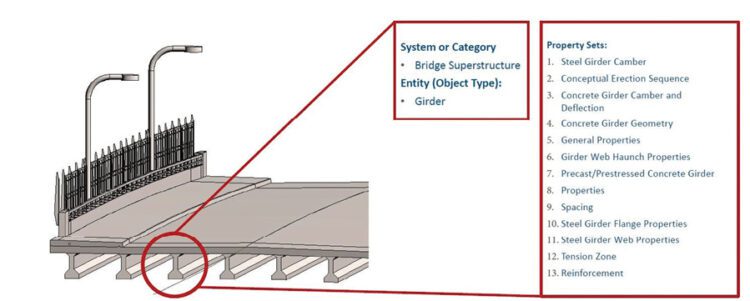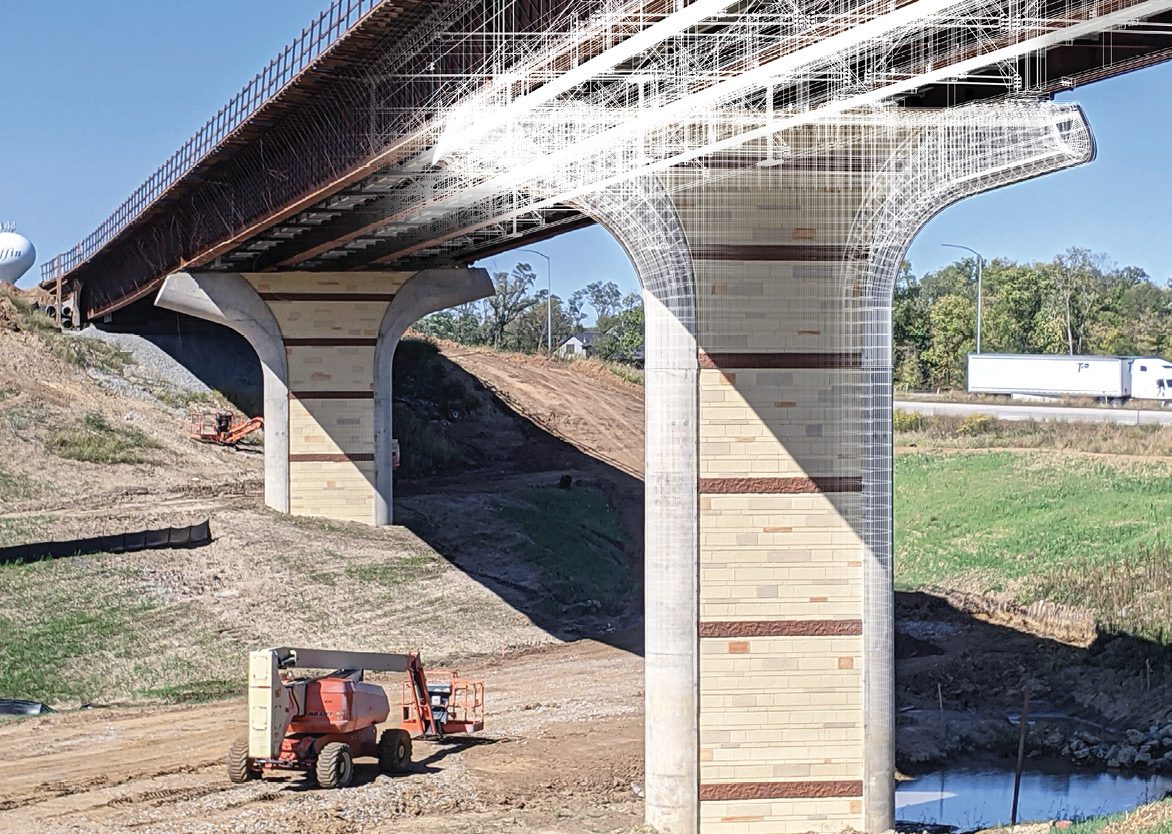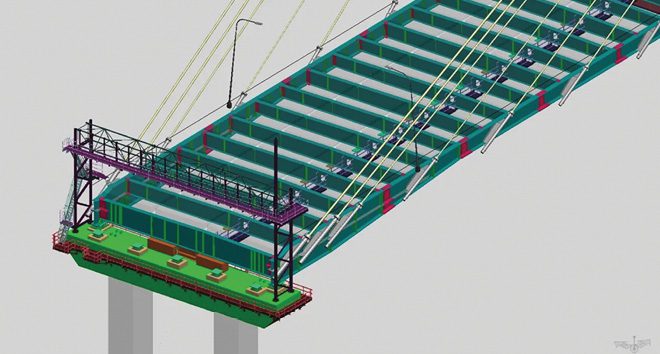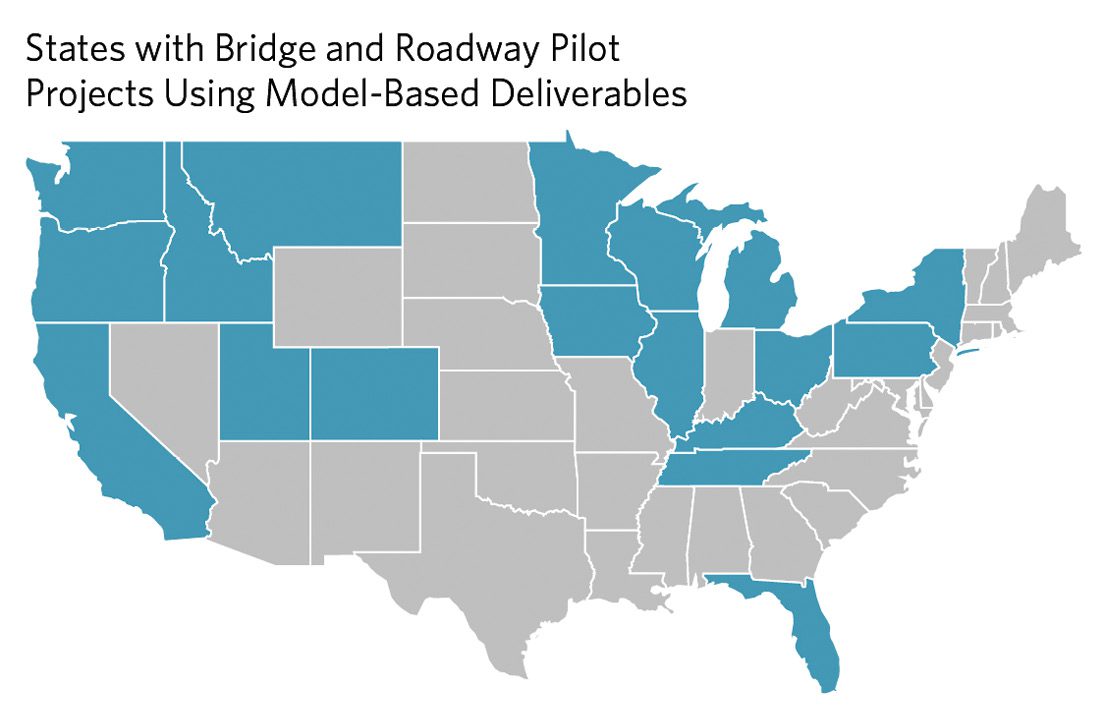On the Front Lines of Standardizing Digital Delivery for Bridge Design

An illustration shows how a specific bridge entity (in this case a steel girder) is categorized and which properties are identified by following the information delivery manual.
In June 2022, the American Association of State Highway and Transportation Officials (AASHTO) took a significant step toward a future in which infrastructure is designed and constructed entirely from digital models. AASHTO’s Committee on Bridges and Structures unanimously adopted the “Information Delivery Manual: Guide Specification for Design to Construction Data Exchange for Highway Bridges.” This construction guide specification lays out the information requirements for delivering model-based bridge designs to facilitate bidding, initiation of fabrication and execution of construction.
What Is an Information Delivery Manual?
As transportation infrastructure design moves toward a future in which plans are delivered digitally as models, it’s key to understand what needs to be in those models. An information delivery manual lays out those information requirements in narrative format, explaining which data are necessary for the contractor to bid and construct the bridge, and which data are needed for the bridge fabricator to initiate their process. By following the manual, each part of a bridge will be categorized with its relevant properties organized in a predetermined data structure.
Why Is This Step Important?
The information delivery manual adopted by AASHTO is the first U.S. standard for bridges’ 3D model data. The transportation industry is moving toward open data standards for design data to enable streamlined and robust interoperability for public-agency owners, designers and construction contractors. Currently, data are created in proprietary formats, which complicate the handoff of digital data from design to construction.
Defining a standard information requirement sets the direction for software developers to seamlessly and reliably import and export the digital bridge design information required for the contractor to bid and construct the bridge. This document also sets the bar for other information delivery manuals. The first of its kind, it will serve as a model for additional data exchanges in the transportation industry for design, construction and asset management.

(HDR)

Images show the promise of a common specification for bridge data. (Iowa DOT)
How Did We Get to This Milestone?
The manual is a product of the ongoing “Building Information Modeling (BIM) for Bridges and Structures pooled fund study,” supported by AASHTO, the Federal Highway Administration (FHWA) and 24 state Departments of Transportation (DOTs) (for more information on the study, visit bit.ly/3fZgzwO). Iowa DOT is the lead agency, and HDR is leading the consultant team delivering the work.
The cooperative effort has an overarching goal to create a national open data standard for bridge design, construction and fabrication. At the end of this process, design and construction software packages will have a streamlined and reliable open data exchange, much like a 2D document can be shared using a non-proprietary PDF, for designers to pass detailed 3D model information with attributes to contractors or fabricators. This will allow each entity to work in their chosen BIM program but still efficiently share robust digital data. It will set the stage for more automation during construction and fabrication as well as open the door to better asset management.

A growing number of state DOTs already are moving forward with model-based deliverables. About a third of state DOTs now require a for-information-only BIM model on projects. And some states have gone further, making the model the primary contractual document—in many cases eliminating selected 2D plan sheets. At least nine states have completed or are in the middle of pilot projects that use a model as the signed and sealed legal document.
At the end of this process, design and construction software packages will have a streamlined and reliable open data exchange, much like a 2D document can be shared using a non-proprietary PDF, for designers to pass detailed 3D model information with attributes to contractors or fabricators.
The information delivery manual adopted in June 2022 was developed by bridge engineers and BIM experts across the United States and shared with state DOTs for feedback to ensure it met the needs of each state.
What’s Next?
With the information delivery manual approved, the BIM for Bridges and Structures team is turning its attention to the development of a model view definition (MVD), which takes the narrative information in the manual and converts it to machine-readable software code that software vendors can use to incorporate IFC-based open data imports or exports into their design and construction software. The information delivery manual was a prerequisite for the MVD.
After the MVD is complete, major software vendors have agreed to modify their software to read models in the specified open data format, and software certification materials will be developed to confirm that off-the-shelf commercial design and construction software are accurately accommodating this standard format.
Adoption of this guide specification is a major step in standardizing digital workflows for bridge construction and moving toward planless delivery and a “Model as the Legal Document” approach. In turn, it represents a significant milestone in developing open data standards for road and bridge transportation projects in the United States.
Utilizing the buildingSMART openBIM international efforts to enhance interoperability, this effort charts the path forward for easier collaboration between design and construction, allowing the industry to leverage the efficiencies and capabilities of today’s advanced modeling software. The current pooled fund work began in 2018 and is anticipated to continue through early 2024. The Iowa DOT also is planning a second BIM for Bridges and Structures pooled fund study to commence in 2024 to further advance progress toward digital workflows and open data standards.
About Julie Rivera
Julie Rivera, P.E., is a senior bridge engineer and HDR’s project manager for the BIM for Bridges and Structures pooled fund study; email [email protected].


